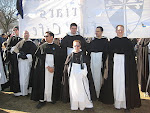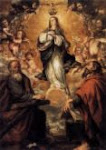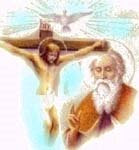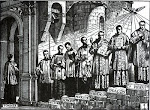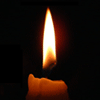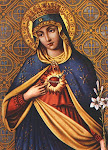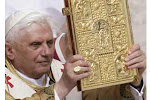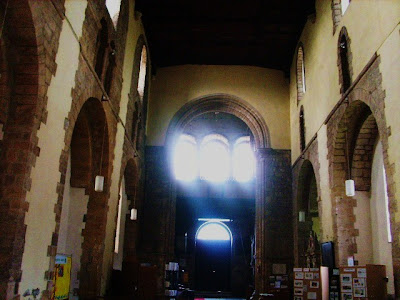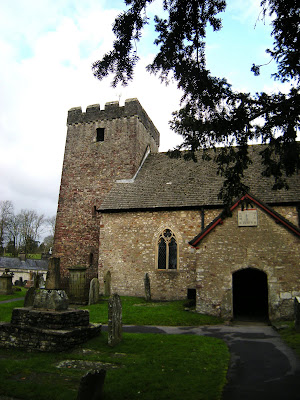
____________________________________________________________________________
Priory of Our Lady,
Striguil (Chepstow)Founded by 12 French Monks from the Abbey of Cormeilles in Normandy, by William FitzOsbern and then his son, Roger of Bretuil (Bristol)The lands between the Usk and the Wye were given over to Cormeilles for rent to found the Priory.Pope Alexander III confirmed the gift, and Henry II granted a charter. In the Wentwood Survey of 1271, the Prior was said to have been entitled to houseboot and hayboot'by prescription since the Conquest'(Wood 1910-42-43) but there was a dispute with St Kynemark's (Cynfarch) over this.It does show the early foundation sate to be likely, however.
Duties of the BenedictinesSt Benedict had reformed monastic life by his Rule , and the Normans were powerful supporters of the Benedictines, having had a care for their future after death. These monks did all their business for them, collecting tithes and taxes , bringing the chaotic into order and acting as a civil service for the new Lords. They had to keep records as well. Benedictines took over some original Welsh Church sites, but some, who were celibate were allowed by the Normans to remain if they embraced the Augustinian Rule, follwing the 'Desert' charism of the Ancien Welsh Churches anyway.
In addition, the Benedictines had considerable spiritual duties to perform-all the customary Sacraments, caring for the sick and becoming a sort of Social services as well. The Word 'DOLE' came from the Abbeys and Priories. In addition, the Benedictines had to service the Chapel of Our Lady in the casle itself.
Sub Tuum (Contemporary prayer to Our Lady-as the monks wuld have understood it)
Sous l'abri de ta miséricorde,
nous nous réfugions, Sainte Mère de Dieu.
Ne méprise pas nos prières
quand nous sommes dans l'épreuve,
mais de tous les dangers
délivre-nous toujours,
Vierge glorieuse, Vierge bienheureuse
I have spoken on the blog a great deal about how the Normans tried to subdue Wales , giving the Marcher Lords of Wales huge powers to conquer lands. He would both keep them busy AND gradually conquer Wales and the Welsh. Castles were built all over and the Welsh called the Normans ‘The Castle Men’. Over the next three hundred years many religious houses sprang up, firstly catered for by the Benedictines. Castles occupied many places on the Marcher Borders. I also mentioned it was not Norman policy (in the beginning) to subdue the Welsh .Monmouthshire, as I said was won by the quarrels the Welsh princes, such as Prince Meredith had among themselves, enlisting Norman help in fighting each other.
These Priories, erected by the Normans , in the main, next to the new Castles were to afford the new French monks protection. All were dedicated to Our Lady and the Chepstow Priory was founded from the great Abbey at Cormeilles.
OTHER BENEDICTINE PRIORIESAbergavenny Our Lady and St Florent 1100-1135-Hammeline de Balun, first Norman Lord of Abergavenny
Usk Our Lady, (now St Mary’s Parish Church)St Mary Magdalene and St Radegunde of Thuringia! was formed later as a Nunnery with six nuns, connected with the family in the local castle.Famous Mediaeval shrines.
Llangua, (Laln-Ciwa-St Kew)Priory Monks from the Abbey of Lire (Lyr)
Monmouth Priory 1101(Our Lady and St Florent)
Withenoc,Lord of Monmouth 1075 -1082.St Florent, Saumur.
And at the top of the county were:Grosmont (Former Celtic settlement developed into the large St Nicholas Church)
Skenfrith (the former St Bridget Settlement made into St Bridget’s Church)
Castell Gwyn (Gwyn’s Castle) erroneously called ‘White’ Castle
Several more Benedictine Establishments in the South of Gwent were:
Benedictine Priory of St Mary Magdalene,Goldcliff White Benedictines Bec Abbey)
These monks were famous for strengthening the sea wall created by the Romans. They came from the Abbey of Bec , also in Normandy and wore white habits.The Abbey of Bec has been restored to Benedictine use as an Abbey.
Benedictine Priory of Our Lady, (Cluniac)at Malpas(Cluniacs from Montecute Abbey in Somerset)
Benedictine Priory of Bassaleg near Modern Newport (from Glastonbury Abbey)A small cell holding lands at Mendelgief.
St Peter’s Abbey Gloucester received the Old Welsh churches at
St Gwynllw’s (Woolos’) Newport
St Bride’s Wentloog (Gwynllwg)
The Benedictines had many duties, apart from seeing to the legal and domestic matters of the Lord of the Manor. It was their duty to organise the Lord’s Lands and business affairs, as well as their necessarily working to pay for their needs and looking after the affairs of those in their charge
Founding of Chepstow Priory and the CastleWilliam FitzOsbern, (a great supporter of William the Conqueror )built Chepstow Castle and founded the Priory from the Abbey at Cormeilles, which was named after the Beati Spetri de Cormeliis (1171) It lies on the old Roman Road going to Lisieux-, (famous home of St Therese in the nineteenth century). In 1055 William FitzOsbern founded the Abbey of Notre Dame et Saint Pierre at Cormeilles ,which was occupied by Benedictines monks until the French Revolution. Most of the abbey buildings were destroyed in 1778, and sadly, only the facade of the abbey and its enclosing walls survive.
Chepstow in Saxon TimesThe Welsh called Chepstow ‘Ystraigwl' (
us-try-gool) meaning ‘The bend’.
During Saxon times, the Chepstow area was of some importance. Harold had conquered it, but in general left the local Welsh to get on with running the ferry from Sudbrook. Nothing much was situated actually at Chepstow until the Norman Conquest and the building of the Castle on a site carefully chosen by them to control shipping into the Wye . The Priory was built as a package with the Castle, as I will explain later. Shoesmith who did recent exavations at the old Priory Church, believes that Nelson street was constructed next to a Roman road, which served as a boundary for the grounds of the Priory.
William FitzosbernWilliam Fitzosbern, who was given the Lordship of Striguil after the conquest, was not totally happy and wandered back to Normandy and sadly died in a battle. He had built Chepstow to subdue the Welsh and control the River Wye and collect the lucrative taxes due for using the River,
Insofar as possible, as far as the Church was concerned, the Conqueror attempted simply to take over the pre-Conquest structures and to exploit them for his own ends, always trying to satisfy the pressures acting upon him with a minimum of expenditure and loss of personal power.
William the Conqueror as a Politician and William FitzOsbernWilliam made brilliant choices in his choice of Bishop of Llandaff and St David’s, men of Welsh extraction who had great empathy with their flock and clergy. What he had to do was be practical and not cause conflict all the time. When the conquest of South Wales began, FitzOsbern began to build Chepstow Castle, and the Priory of Our Lady, which he founded in 1071, sixteen years after he founded its mother house in Cormeilles.
Twelve Benedictine monks arrived and supervised building work and prayed for the souls of the Conqueror and his Knights, presumably because of the bloody way William dealt with the Northern English and rebellions in various places.
William FitzOsbern was. born in 1020 and died in 1071, after he had begun to build the castle and Priory. He was Lord of Breteuil, from where we get the name of ‘Bristol.’ He was a relative and close advisor William the Conqueror. William FitzOsbern became one of the great magnates of early Norman England having been right hand man of the Conqueror. He was created Earl of Hereford in 1067, one of the first peerage titles in the English peerage.
William FitzOsbern was probably raised at the court of his cousin and namesake Duke William, and , like his father, became one of the ducal stewards. He urged William to invade England, and tradition holds that he convinced the doubters amongst the Norman barons of the feasibility of the invasion.
As Duke William took control of England (becoming William I of England), FitzOsbern was given charge of the Isle of Wight, and then in 1067 was given the status of an earl. He is generally considered Earl of Hereford, though his authority may have extended to some of the neighbouring shires as well. In any case, that part of England was not yet under Norman control; the understanding must have been that FitzOsbern was to take charge of their conquest when he was able.
FitzOsbern as Regent of EnglandAlso for the central part of 1067 the king returned to Normandy, leaving FitzOsbern in charge of England. The king was back in England in 1068, and FitzOsbern accompanied him in conquering southwest England. He attended the king's Whitsun court in May, and then himself paid a visit to Normandy, where he fell ill for some months.
Adeliza de TosnyIn 1069 FitzOsbern and his followers pushed on into Wales, beginning the conquest of Gwent. FitzOsbern’s first wife was Adeliza de Tosny who had died prior to 1069 and was buried at his beloved Abbey in Cormeilles, where he also was later himself laid to rest.
As part of the assertion of Norman control over England (and Wales), FitzOsbern was one of the major Norman castle builders. Early castles attributed to him include Carisbrooke,Isle of Wight(also monks from Cormeilles) Chepstow (Striguil), , and Monmouth.
FitzOsbern dies and leaves his property to his son, Roger of Bretuil (Bristol)Fitzosbern founded the Priory of Striguil and was persuaded to lend help to the Cistercian monks of Tintern Abbey to build their new Abbey. In 1070 trouble arose in Flanders, where king William's brother-in-law Baldwin VI of Flanders had died, leaving his county and his young sons in the hands of his widow Richilde, Countess of Mons and Hainaut.
Her control of Flanders was challenged by the brother of her late husband, Robert the Frisian. Looking for help, she offered herself in marriage to FitzOsbern. He could not resist the chance to become also count of the rich principality in the German Empire, close to Normandy. He married Richilde shortly before the Battle of Cassel He hurried there with his army, but nevertheless was defeated by the Count of Flanders: FitzOsbern lost his life in the Battle of Cassel on February 22, 1072. He was succeeded in Normandy by his eldest son, William of Breteuil, and in England and Wales by his younger son, Roger de Breteuil.
Robert de Bretuil begins to build the Priory at Striguil (Chepstow)Building work started in 1072, under the supervision of Roger de Bretuil and confirmation of its status was confirmed in a Papal Bull of 1168 by Pope Alexander III. It is one of the few Norman buildings designed to be vaulted. The arcades consist of massive square pillars under whose arches you could once walk into the nave. In 1841, during a Victorian reconstruction) these square pillars were sadly removed. John P Harris in the guide book to the Priory church writes ‘Notice that the spaces in the upper wall above the arcade, called the ‘Triforium’are not the same on each side of the church which is called ‘the nave’ In many ways, the Normans left the lands of the church alone but they did bring a semblance of order to a Celtic church which had become somewhat disorganised,in its amalgamation with the Saxon Church, although thriving with numbers, excellent teaching and faith..
Taxation of Pope Nicholas The Priories of Chepstow and Striguil are one and the same. There is no mention of Chepstow in the donations to Cormeilles . FitzOsbern, the founder of Tintern Abbey is called the Lord of Striguil alias Chepstow.
In 1291 in the Taxation of Pope Nicholas there were several entries for Striguil/Chepstow where we learn that two of their pigs had to be paid ! from Tidenham 1/- and from Stonehouse £1.6s 8p. The Abbey was seized as an ‘alien’ priory by the crown during the French wars, but restored by Henry IV. In the second year of his reign, Henry IV granted the Priory to the College called ‘God’s House’ at Cambridge but the grant seems not to have taken effect and the priory remained here as a Denizen house (A local house) until it was seized by Henry VIII and Cromwell, when it had only three monks left and was valued as at the clear annual income of £32.3s. Chepstow sent annual taxes to Cormeilles.
In the time of war, the reigning king would receive the revenues and appointed the vicar. In 1415, alien priories were transferred to the crown and Chepstow was attached to Bermondsey. It probably became independent in 1442.
How the monks used the PrioryThe monks held their services in the chancel and the transepts , separated by a stone ‘pulpitum’ (screen) from the nave where it was used by the people for their parish church. It was here that the monks would come every day and pray the Liturgy of the Hours and the Mass. Essentially the Liturgy of the hours has not changed from then until today, except that it would have been in Latin, which all the monks understood.
During the vandalism of the ‘Reformation’ the transepts were ripped down and the monastic end taken away. The tower remained in the middle of the church.The Victorians during their renovations replaced the transepts and built some of the monastic end on again for a high altar. The tower became unstable in 1701 and the western tower was moved to the West end of the Priory Church.
The Present ChurchThe present Church consists of a shallow chancel, transepts, clerestoried nave of four bays, and battled western tower, erected in 1705-6, rising within the church, and in part built on the ancient front; it contains 8 bells and a clock with chimes; of the central tower, which fell down in 1701, there remains only the base of one of the massive piers once probably supporting it.
In 1841 the whole fabric, in order to provide an increased number of sittings, was extensively altered The late shallow chancel was erected and the transepts enlarged by destroying the eastern bay of the nave and incorporating it in new transepts; the aisles were also pulled down, and the arcades, consisting of plain round arches on massive square piers, built up; the north porch was removed, and its Norman arch placed under the tower, the western gallery was extended, and other galleries were erected in the new transepts.



 Benedictine Religious Houses
Benedictine Religious Houses_____________________________________________________________________________________
Earliest Benedictines at StriguilPriors of StriguilDom John de Hemmyngsbourg Resigned promoted to Goldcliff 26April 1349
Dom Ralph de Compton(Vicar of Goldcliff)
16th June 1349
Dom William Guby Chaplain18th August 1382
Dom John Heppern Chaplain18 November 1394
Dom Charles de WenlockClerk,|Appointed Farmer of the alien priory at Chepstow during the war with France
12 February 1393
Dom John Davy, Chaplain




______________________________________________________________________________________More About Chepstow Priory next!
.JPG)
.JPG)
.JPG)
.JPG)
.JPG)
.JPG)
.JPG)
.JPG)
.JPG)


 _____________________________________________________________________________
_____________________________________________________________________________



